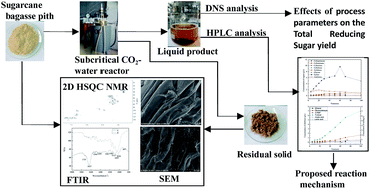Hydrolysis behaviors of sugarcane bagasse pith in subcritical carbon dioxide–water
Abstract
The aim of this study was to describe the hydrolysis behavior of sugarcane bagasse pith (SCBP) in subcritical CO2–water. The hydrolysis was carried out in a batch reactor using different temperatures (160 to 260 °C), liquid to solid ratios (20 : 1 to 100 : 1), CO2 pressures (0 to 7.3 MPa), stirring speeds (0 to 500 rpm) and reaction times (0 to 40 min). The highest total reducing sugar yield (43.6%) was obtained at 200 °C, liquid to solid ratio 30 : 1, 2 MPa CO2, 500 rpm and 50 min. Two-dimensional heteronuclear single quantum coherence (2D HSQC) nuclear magnetic resonance (NMR), scanning electron microscopy (SEM) and Fourier transform infrared spectrometry (FT-IR) were used to help elucidate the physical and chemical characteristics of the raw material and residual solid particles, with results consistent with the removal of hemicellulose during hydrolysis. The changes in the concentration of products with time were analyzed to understand product distribution through high-performance liquid chromatography (HPLC) and to infer the reaction mechanism.


 Please wait while we load your content...
Please wait while we load your content...